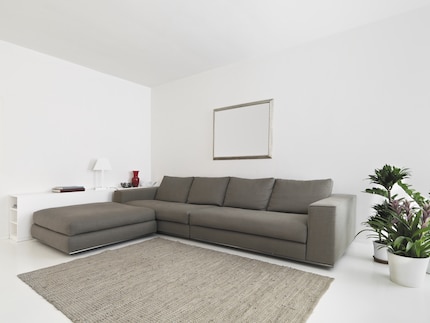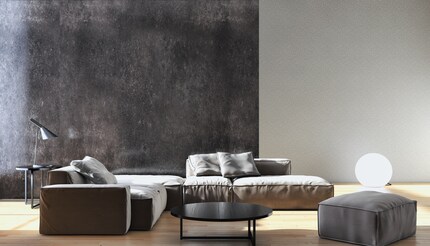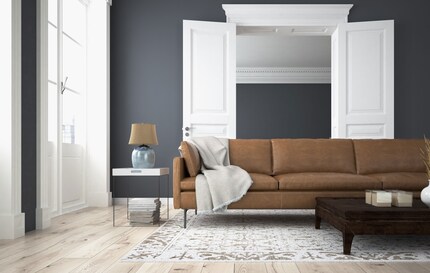

It doesn't always have to be white
Caffe latte, azure blue, dove tale, mauve and co. There are now thousands of colour shades to choose from. So why do so many people still opt for white walls in their homes? I'll explain why - and give you tips on choosing the right colours and design options.
White is associated with neutrality and timelessness. The colour white is often chosen to create a neutral environment. We have the feeling that we are not doing anything wrong with it. Yet colours subconsciously play an important role in our lives. They influence our well-being and affect our emotions. For example, we often find rooms in natural and grey tones much cosier than completely white rooms.
Designing the room with colour

White is not always the right choice. Individual pieces of furniture can appear isolated in a white environment. If, on the other hand, you use a colour tone, you can create a reference to individual accessories and pieces of furniture and thus create a harmonious overall concept. The use of wall colour can lend a room a restrained or exciting character. You can influence the perception of room proportions and achieve a completely new spatial effect.
This is why it is important to think about the following points in advance: How do you want the room to look? Airy, calming, unusual or cosy? How often do I spend time in this room? What colour tones do I like? Should all the walls be painted or just individual areas emphasised? And what kind of mood do I want to achieve?

Colour fans, sample cards or small colour samples help to select the right colours. These are available from most manufacturers (NCS, Farrow & Ball, Little Greene, Flamant and others). Always use these samples to help you. If you are not one hundred per cent sure of the colour shade, it is very helpful to make a large-scale sample. Colour samples should always be viewed on site. The effect varies greatly depending on the placement and incidence of light.
Highlighting individual areas

Rooms don't always have to be painted all over. To make open, large rooms look cosier, you can simply highlight individual walls in colour. Cold and warm colours should not be mixed. It is helpful to focus on one colour family and then work with different brightnesses and nuances. Furniture, textured carpets, curtains, fabrics and accessories in natural materials & harmonious colour nuances enliven the room on their own. Use magazines and specialist books as a source of inspiration for ideas.
Ceilings should always be painted in a neutral white colour. The contrast with coloured walls makes the room appear higher. Wall-ceiling transitions are not always straight. To avoid visible wavy lines, the coloured paint should stop 10-15 mm below the ceiling. A narrow masking tape helps to achieve a clean, straight finish and irregularities are no longer noticeable.
Setting the scene for the interior

If you have the courage, you can dare to use dark colours. Your favourite piece of furniture looks great against a darker wall. Architectural elements can be deliberately emphasised or concealed with dark colours. Combining a warm grey, charcoal or black with muted tones and natural materials such as light oak will definitely add character to a room. It is important not to just create monotonous dark surfaces, the dosage and combination with other materials is crucial here.
Wallpaper, illustrations or graphic murals can be used as an alternative to a bucket of paint. Wallpaper combines pattern, colour and a textile feel. A smooth surface is required to apply wallpaper. Old wallpaper should be removed from the wall beforehand. You can of course find inspiration at Galaxus or at Tapetenraum.ch. Large-format boards such as MDF (medium-density fibreboard with a high surface density) are also suitable for illustrations and graphic murals. Wallpaper or prints can be applied to a primed panel and placed flexibly in the room.
If you still want to design your walls in white, not all white is the same. Here too, there are a variety of shades. Pure white, chalky white, off-white, etc. It's worth taking a look at a colour fan.
But before you reach for a brush and paint, you should clarify whether this is permitted in rented flats. As a rule, coloured walls should be returned to their original state when you move out. Then there will be no trouble.
Let yourself be inspired.
Colour frenzy at Galaxus
I like to spend my time with creative projects, friends & family and delicious recipes from all over the world. Travelling to distant countries, discovering foreign cultures and observing people are the cornerstones of my creativity. All this inspires and motivates me in my work. The challenge of giving a room or an object a soul, arousing emotions and at the same time creating something functional and practical fascinates me. I think interests only become passions when you can share them not only with yourself but also with other people. Together with my colleague Michael Sollberger I founded the interior design studio "MOOMII" in 2016.
From the latest iPhone to the return of 80s fashion. The editorial team will help you make sense of it all.
Show all

